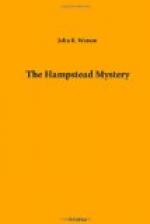“Look at that plan again,” said the K.C. “Have you ever had paper like it at your flat?”
She shook her head.
“Never.”
“Have you ever seen paper of that kind in Birchill’s possession before he showed you the plan?”
“Never.”
“When he showed you the plan had the paper been folded?”
“Yes.”
The K.C. took the witness, now very much at her ease, to the night of the murder. She denied strenuously that Hill tried to dissuade Birchill from carrying out the burglary because Sir Horace Fewbanks had returned unexpectedly from Scotland. It was Birchill who suggested postponing the burglary until Sir Horace left, but Hill urged that the original plan should be adhered to. He declared that Sir Horace would remain at home at least a fortnight, and perhaps longer. His master was a sound sleeper, he said, and if Birchill waited until he went to bed there would be no danger of awakening him. She contradicted many details of Hill’s evidence as to what took place when the prisoner returned from breaking into Riversbrook. It was untrue, she said, that there was a spot of blood on Birchill’s face or that his hands were smeared with blood. He was a little bit excited when he returned, but after one glass of whisky he spoke quite calmly of what had happened.
The next witness was a representative of the firm of Holmes and Jackson, papermakers, who was handed the plan of Riversbrook which Hill had drawn. He stated that the paper on which the plan was drawn was manufactured by his firm, and supplied to His Majesty’s Stationery Office. He identified it by the quality of the paper and the watermark. In reply to Mr. Walters the witness was sure that the paper he held in his hand had been manufactured by his firm for the Government. It was impossible for him to be mistaken. Other firms might manufacture paper of a somewhat similar quality and tint, but it would not be exactly similar. Besides, he identified it by his firm’s watermark, and he held the plan up to the light and pointed it out to the court.
Counsel for the defence called two more witnesses on this point—one to prove that supplies of the paper on which the plan was drawn were issued to legal departments of the Government, and an elderly man named Cobb, Sir Horace Fewbanks’s former tipstaff, who stated that he took some of the paper in question to Riversbrook on Sir Horace’s instructions. And then, to the astonishment of junior members of the bar who were in court watching his conduct of the case in order to see if they could pick up a few hints, he intimated that his case was closed. It seemed to them that the great K.C. had put up a very flimsy case for the defence, and that in spite of the fact that the prosecutor’s case rested mainly on the evidence of a tainted witness Holymead would be very hard put to it to get his man off.
“Isn’t my learned friend going to call the prisoner?” suggested Mr. Walters, with the cunning design of giving the jury something to think of when they were listening to his learned friend’s address.




